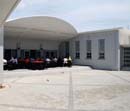The Caribbean is today one of the most dynamic, vibrant and colorful regions of the Americas, a sought-after travel destination not for a good rest, but also for learning about its rich cultural diversity. Over five centuries of history have allowed the area to amass an artistic heritage –especially in architecture– that help out the region on the map with a significant amount of landmarks listed as World Cultural Heritage by UNESCO. Unfortunately, only a handful of them –adding up to several dozens- are strictly labeled as modern architecture or urbanism, despite the undisputed quality of many works built between the 1920s and 1970s both in the insular Caribbean and in mainland.
An assessment of the works contained in that category in any part of the world would reveal that a majority of them belongs to the past and to artistic styles before the Modern Movement. A similar situation can be found with the national monuments. This circumstance likened to objective factors –like the value ingrained in longstanding works– and subjective ones –the lack of clear understanding on the part of some experts and the general population, coupled with limited adjudication of heritage character to the most recent architectural gems– has begun to turn back. Now the number of works hailing from the 20th century is closing in to the 20 mark. Among others, Brasilia has been labeled in that category in 1987 (architects Lucio Costa, Oscar Niemeyer and others, 1956; and the university campus of Caracas in 2000 (architect Carlos Raul Villanueva, 1940-1960); the university campus of Mexico in 2007 (architects Mario Pani, Enrique del Moral and others, 1950-1952). In Cuba, following a long claim staked by local and foreign experts, a file is in the works for a proposal to the World Heritage Center (WHC) on the five national art schools of Cubanacan (architects Ricardo Porro, Vittorio Garatti and Roberto Gottardi, 1961-1965). As WHC President Francesco Bandarin said, the willingness to accept, assess and classify modern works as part of the World Heritage “is completely open and positive, and if the number is not bigger right now is just because not enough proposals have been made.”1 Therefore and based on the immense architectural, social and cultural values the art schools have to offer, is quite likely that Cuba will sooner rather than later have a modern work listed as World Heritage.
The declaration could have a beneficial collateral effect on the region by helping the broadest public –specialized or not– feel drawn to the modern period. The evidence derived from the analysis of the Caribbean’s major cities shows that regardless of their possessing priceless historic cores from the colonial rule worth preserving for forever more, those cores –as in the case of Old Havana- are too small in surface as compared to the rest of the burgs and that the amount of works dating back to the colonial time is relatively undersized, while the largest urban and architectural development came in nearly each and every one of them during the course of the 20th century –a time of stepped-up increase of a modernity that had already taken its big break circa the mid 19th century.
There’s a need today to embrace a vast and inclusive understanding of the monument and heritage concepts that could allow the valuable acceptance –and therefore the protection– of most of what was built in the course of the century in areas other than the cores that contain the traditional monuments. The enhancement of this notion hinges heavily on the future character of the Caribbean cities: whether they’d manage to maintain a historic core protected and kept alive by tourist inflows, yet surrounded by rundown buildings dwelt by residents who would be forced to migrate to the old downtown areas of town in search of a better life; or the city will eventually be construed as a comprehensive entity where it will be paramount to save everything valuable, either old or new, rather than prompting shortsighted interpretations and insufficient actions that at the end of the day could make an incomplete selective perdurability prevail, either based on chronological, economic, political criteria or of any other kind.
Especially in the Cuban capital, could it be possible to deny the undisputed values of El Vedado, Centro Habana, Cerro, Miramar, Siboney and Cubanacan, just to name but a few examples of neighborhoods situated outside what has traditionally been viewed as the city’s historic core? In those areas, the abundance of urban and architectural merits is so visible that it’s hard to believe why the lack of protection and control on some of insensitive and unwise actions, openly opposite to the preservation of their values, are so overwhelming. Even though it’s true the art schools can be seen as the flagships of the region’s modern architectural movement, they are not the only works pigeonholed in that category that call for serious assessments and all-out protection. On the contrary, the tremendous amount of modern creations worth conservation efforts leads us to asserting that would have we had the visionary attitude of adequately preventing those modern gems from decaying or being transformed –works that must be passed on to the new generations– the quantity of funds earmarked for restoration could be slashed dramatically. Something similar could have been possible if our ancestors would have paid more heed to the colonial heritage that today calls for so much hard work in its refurbishment.
At an international level, the most significant step taken for the protection of modern heritage has no doubt been the foundation of the International Task Force for the Documentation and Conservation of Modern Buildings, Sites and Neighborhoods (DOCOMOMO International) in 1988, originally based on Holland’s Delft and headquartered in Paris since 20022. This organization has played a major role in gathering willingness and support for the acceptance of the heritage concept applied to modern works, as well as to the implementation of campaigns worldwide to support local safeguarding actions. DOCOMOMO currently gathers over fifty countries, including some from the Caribbean Basin.3 DOCOMOMO Journal, the entity’s magazine, put out a special issue on the insular Caribbean back in 2005.4
Three decades ago the salvation of our region’s colonial heritage seemed more of wishful thinking. Today, though, it’s a reality. As far as the modern heritage is concerned, the expansion of the DOCOMOMO International membership, as well as the close collaboration among national groups, will increasingly bridge the gap between reality and chimera: the consideration and labeling as local and national monuments –even as part of the World Cultural Heritage– of a great deal of modern works built –some of them- as recently as in the 1950s, 60s and 70s, a period of splendor in the Caribbean region’s construction. Consequently, this will guarantee the safeguarding of a legacy of unfathomable value in terms of its integrality, an effort that must undoubtedly embrace the protection of specific local landmarks based on their history, climate and geography –yet all of the sharing a lot in common- that gave a touch of variety, within the boundaries of unity, to the rich Caribbean identities.
Bibliography
Rodriguez, Eduardo Luis & Gustavo Luis More: “The Sinuous Pace of Modern Architecture in the Insular Caribbean”, in DOCOMOMO Journal, Paris, is. 33, 2005, pages 5-8.
Rodriguez, Eduardo Luis: The Havana Guide, Modern Architecture, 1925-1965. New York: Princeton Architectural Press, 2000.
Saavedra Bruno Sofia, Michael Newton & others: The impact of Caribbean Modern Architecture. Willemstad: The University of the Netherlands Antilles, 2009.
Vivoni Farage, Enrique: “Modern Puerto Rico, from the Beginning to Henry Klumb’s Works, in DOCOMOMO Journal, Paris, is. 33, 2005, pages 28-37.




Publicación anterior Cildo Meireles. Against hegemonic ideas in art
Publicación siguiente First Chile Triennial. Scouting the boundaries
Publicaciones relacionadas

Un tejido expositivo con genuinos imaginarios
Diciembre 19, 2024
Geo Ripley: De la sombra a la luz
Diciembre 11, 2024













